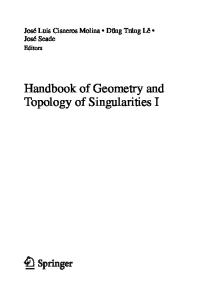Sandpile Solitons via Smoothing of Superharmonic Functions
- PDF / 732,749 Bytes
- 27 Pages / 439.37 x 666.142 pts Page_size
- 12 Downloads / 332 Views
Communications in
Mathematical Physics
Sandpile Solitons via Smoothing of Superharmonic Functions Nikita Kalinin1,2 , Mikhail Shkolnikov3,4 1 Saint Petersburg State University, 7/9 Universitetskaya nab., St., Petersburg 199034, Russia. E-mail:
[email protected]
2 National Research University Higher School of Economicsm, Soyuza Pechatnikov Str., 16, St. Petersburg,
Russian Federation
3 IST Austria, Klosterneuburg 3400, Am Campus 1, Klosterneuburg, Austria.
E-mail: [email protected]
4 Université de Genève, Section de Mathématiques, Route de Drize 7, Geneva, Switzerland
Received: 23 December 2018 / Accepted: 2 June 2020 Published online: 18 August 2020 – © Springer-Verlag GmbH Germany, part of Springer Nature 2020
Abstract: Let F : Z2 → Z be the pointwise minimum of several linear functions. The theory of smoothing allows us to prove that under certain conditions there exists the pointwise minimal function among all integer-valued superharmonic functions coinciding with F “at infinity”. We develop such a theory to prove existence of so-called solitons (or strings) in a sandpile model, studied by S. Caracciolo, G. Paoletti, and A. Sportiello. Thus we made a step towards understanding the phenomena of the identity in the sandpile group for planar domains where solitons appear according to experiments. We prove that sandpile states, defined using our smoothing procedure, move changeless when we apply the wave operator (that is why we call them solitons), and can interact, forming triads and nodes. 1. Introduction Periodic patterns (Fig. 1, left) in sandpiles were studied by S. Caracciolo, G. Paoletti, and A. Sportiello in their pioneer work [2], see also Section 4.3 of [3] and Figure 3.1 in [23], Figure 9a in [28]. Experimental evidence suggests that these patterns appear in many sandpile pictures and carry a number of remarkable properties: in particular, they are self-reproducing under the action of waves. That is why we call these patterns solitons. The fact that the solitons appear as “smoothings” of piece-wise linear functions was predicted by T. Sadhu and D. Dhar in [29]. We introduce a suitable definition of the smoothing procedure (Definition 2.5). We prove (for the first time) the existence (and uniqueness modulo translation) of solitons for all rational slopes (Theorem 1) and we prove that the “mass” (the total defect of the Laplacian, or the total difference from the maximal stable state) of the building block for the soliton of the direction ( p, q) is p 2 +q 2 Nikita Kalinin: Support from the Basic Research Program of the National Research University Higher School of Economics is gratefully acknowledged. Supported in part by Young Russian Mathematics award. Mikhail Shkolnikov: Supported by ISTFELLOW program.
1650
N. Kalinin, M. Shkolnikov
Fig. 1. These are local patterns for the soliton of direction (1, 3) and the triad made by solitons of directions (0, −1), (1, −1), (1, 2). White means three grains of sand, green—two, yellow—one, and red—zero. The rightmost picture (obtained using
Data Loading...











